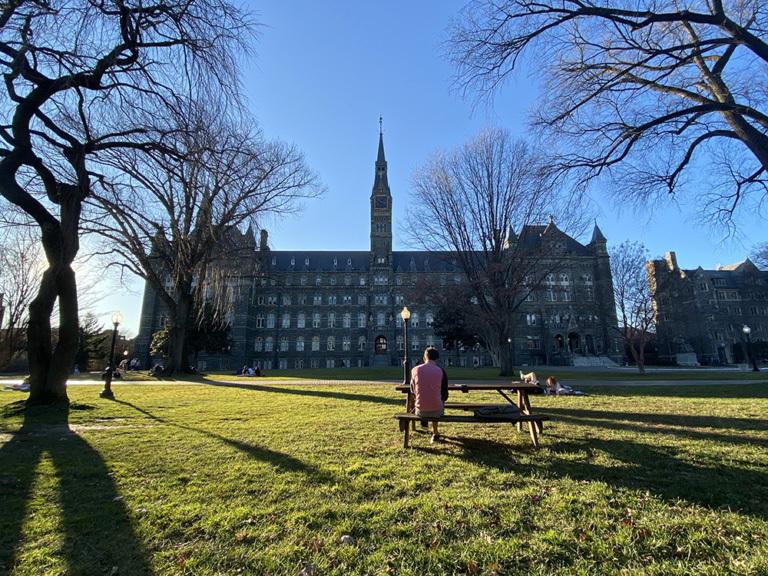Democratic presidential nominee Joe Biden’s free college plan could pay for itself within ten years, despite its multi-billion dollar price tag, according to a recent report.
The Georgetown University Center on Education and the Workforce study, titled “The Dollars and Sense of Free College,” analyzed the costs and benefits of three different models of government-funded higher education: the first-dollar model, in which the government pays the entire tuition; the last-dollar model, in which the government completes the tuition after financial aid is applied; and the debt-free model, in which the government covers the entire cost of attendance.
According to the study, Biden’s plan, which falls under the first-dollar model, is expected to cost $49.6 billion in its first year. If passed, the plan commits to covering tuition to a four-year, public university for people with an annual family income under $125,000. The plan also promises to cover a full community college education for all students.

According to Michael Quinn (GRD ’09), a research analyst at CEW and one of the study’s authors, the cost of Biden’s plan came out much lower than expected, which makes the implementation of the plan more feasible.
“It isn’t cheap, but in the magnitude of other policies that we have gone through as a country, it isn’t so out of the ordinary. The projected cost we have over ten years is roughly in the ballpark of revenue lost from the Trump tax cuts, more or less,” Quinn said in an interview with The Hoya. “I was expecting it to be a lot higher than it was, and it’s much more reasonable.”
Biden’s plan deserves praise for making genuine attempts to promote equity in education, even though it does not go as far as to make the whole college experience free, according to Artem Gulish (GRD ’10), a co-author of the report.
“Compared to plans that are either last-dollar or first-dollar but without the income cap, it would cover more low-income students, it would cover more Black and Latino students, so from that perspective it would be a more effective plan. It still wouldn’t cover all the costs of attendance — a debt-free college plan would potentially cover all the costs,” Gulish said in an interview with The Hoya. “Biden’s plan falls more on the generous side, but not the most generous possible.”
The move toward more free college options has risen to national prominence in recent years, with many states proposing or implementing plans to expand the affordability of higher education. The report mentions various free college plans have already been implemented in 15 states. Democrats in the House of Representatives proposed including a free community college provision in the Higher Education Act during the law’s reauthorization in 2019.
To evaluate and project the final costs and revenues from these models, the study made assumptions of changing future behaviors, according to Quinn. They considered the fact that private school might become less attractive if public education were made free. The research also weighed the fact that people who otherwise would not have been able to attend college would take advantage of the new educational opportunities and apply to school en masse.
“So we took all that into account, and that raised the obvious question of, ‘how much would this actually cost?,’ which is always at the top of people’s minds,” Quinn said.
However, the value of a college education when looking for work will remain relatively constant even if there are more college graduates, according to Gulish.
“The U.S. economy has enough capacity to handle more college graduates,” Gulish said. “College graduates start businesses, they come up with ideas, they help expand businesses, so that creates more jobs. We do not believe in the idea that demand is fixed, that no matter the number of college graduates we have, the demand will be fixed.”
The report estimated new college graduates who would not have otherwise been able to afford college without the Biden program would end up paying more than double the program’s cost in state and federal taxes by the program’s 10th year.
“All we are talking about is that more people will get degrees, they will earn more money, and because they will earn more money, they will pay more taxes. And over ten years, that will start bringing in more revenue than the cost of the program,” Gulish said.
A free-college policy could help lower the financial barriers to attending college, but a lack of transparency and information about programs could present obstacles for prospective students.
“There are people who can get financial aid, there are people who can get scholarships, there are people who can get a better deal at a private college, but the main issue is that especially people who are low income don’t know that,” Gulish said. “It’s very confusing, and that often discourages them from going to college. Having a clear message that you can go to a public college for free, that would change their perspective, change the way they think about their future in terms of college.”
As higher education becomes increasingly important for job placement, Gulish wants people to know they have options to pursue postsecondary education, regardless of whether a free college plan comes to fruition.
“People who are first generation, low income students mainly think this is outside their realm of possibilities,” Gulish said. “We as a country need to do a better job of communication that there are postsecondary pathways and options for everybody and that people have opportunities to pursue those.”




















